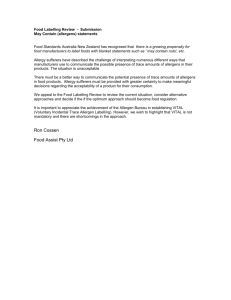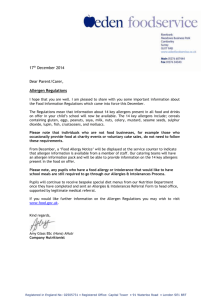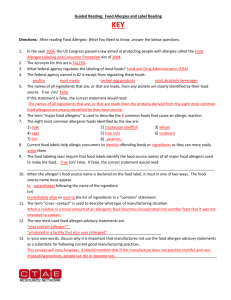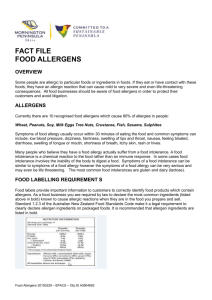FIR May Contain and FreeFrom
advertisement
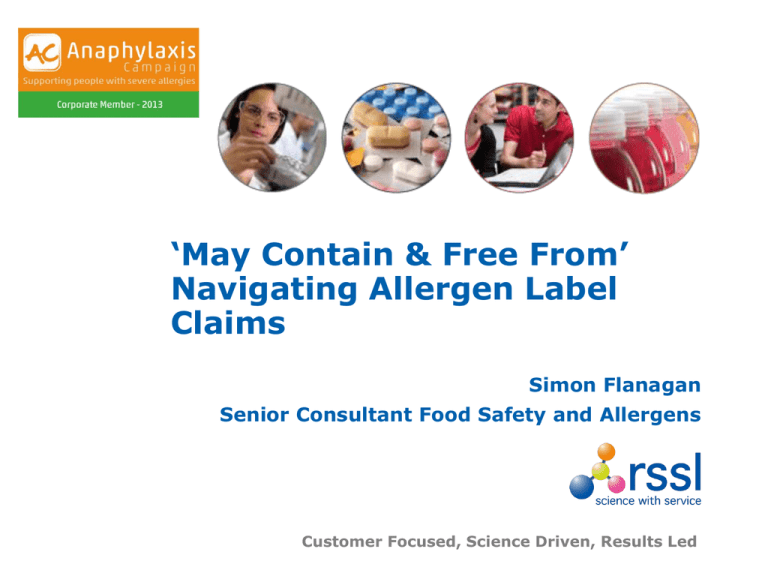
‘May Contain & Free From’ Navigating Allergen Label Claims Simon Flanagan Senior Consultant Food Safety and Allergens Customer Focused, Science Driven, Results Led Overview • Allergen labelling requirements of FIC (1169/2011) • ‘Free-from’ claims – what do these really mean? • The thresholds dilemma & action levels • Latest on precautionary labelling (may-contain) • What must I, and what can I put on the label? Allergen labelling requirements of FIC Customer Focused, Science Driven, Results Led EU Food Information for Consumers 1169/2011 • Regulation 1169/2011 comes into force 13th Dec. 2014 • Establishes a legal framework in the European Union with regard to information related to foodstuffs provided to consumers by food business operators at all stages of the food chain Food intended for the final consumer Foods delivered by mass caterers Foods intended for supply to mass caterers Also applies to catering services provided by transport leaving from the EU Member States (airline catering) – Distance selling (i.e. internet) – – – – • Applicable to pre-packaged and foods sold loose • Regulation covers ‘mandatory’ and ‘voluntary’ particulars 1169/2011 Mandatory Particulars Article 9.1(c): Mandatory particulars. • Any ingredient or processing aid listed in Annex II, or derived from a substance or product listed in Annex II causing allergies or intolerances, used in the manufacture or preparation of a food and still present in the finished product, even if in an altered form • 13 allergens + SO2 (>10ppm) (Annex II) must be declared in the ingredient list regardless of quantity (unless exempt) if intentionally added as ingredients. • Change in the way that allergen information is to be presented (emboldened, underlined, different colour). Non-Prepacked Foods Article 44(1) – national measures for nonprepacked foods • Where foods are offered to sale to the final consumer or to mass caterers without prepackaging, or where foods are packed on the sales premises at the consumer’s request or pre-packed for direct sale, the provision of the information about allergenic ingredients is mandatory What does this mean for the food service sector in UK? • Businesses must provide information on Annex II allergens used as ingredients in dishes – saying that you do not know if an allergenic food ingredient is present, will no longer be allowed – nor can you say that all the foods could contain certain allergenic ingredients • Information has to be placed in a conspicuous place, be easily visible, clear and legible • Oral provision will also be permitted, but needs to be consistent and verifiable, if challenged. • Signposting to oral information is required • FSA guidance being updated BRC / FDF Guidance – Interpretation of 1169/2011 • Name of allergen suffixed i.e. anchovy (fish) unless allergen included in name of ingredient; i.e. skimmed milk powder • Milk will be declared after cream, butter and cheese despite consumer understanding • The named nuts in Annex II of the Regulation will be listed by their specific name and not suffixed by (nut)* • Cereals containing gluten will be declared in the ingredients list using the specific name of the cereal, i.e. wheat, rye, barley, oats, spelt or kamut * Exemption: pecans and macadamias will be declared as pecan nuts and macadamia nuts. For these nuts, both words ‘pecan’ and ‘nuts’ should be in bold, for consistency with nuts such as hazelnuts. Mandatory – Example Labels* * BRC Guidance on Allergen Labelling & the Requirements in Regulation 1169/2011 1169/2011 Voluntary Particulars • Article 36.3(a): Additional voluntary allergen labelling (“may contain” – information on the possible and unintentional presence of substances or products causing allergies or intolerances) • Article 36.2 covers the general requirements that voluntary food information must meet: – (a) it shall not mislead the consumer, as referred to in Article 7; – (b) it shall not be ambiguous or confusing for the consumer; and – (c) it shall, where appropriate, be based on the relevant scientific data. • Article sets out implementing acts at member state level • Contains / allergy advice box used in current format on a voluntarily basis by manufactures & retailers will not be permitted after Dec. 2014. Voluntary Guidance* – Replacing the Allergy Advice (Contains) Box Voluntary Voluntary * BRC Guidance on Allergen Labelling & the Requirements in Regulation 1169/2011 Free-From Claims Customer Focused, Science Driven, Results Led Free-From Claims • Claims not currently within the scope of FIC • Only currently have legal limits for ‘gluten-free’ & ‘very low gluten’ (EC 41/2009) • Patchy regulation and sparse published best practice guidance therefore manufacturers, retailers and foodservice setting own polices • In absence of limits many companies relying on combination of high level allergen control & positive release (non-detectable at LOD / LOQ) • Invitation to purchase by potentially most at risk consumers • No such thing as zero but this is what many consumers expect! • Sector key focus of Enforcement surveys FSA “Best Practice Guidance on Managing Allergens with Particular Reference to Avoiding Cross-Contamination” (2007) Section 3.3.2 Allergen-free foods A growing number of food manufacturers and retailers are providing ranges of substitute foods made without certain common allergenic foods, such as milk, egg or cereals containing gluten. In addition, some manufacturers choose to exclude certain allergens from a site. It should not be assumed that the lack of a need to use advisory allergen warnings entitles a product to make a ‘Free From’ or claim. Consumers are likely to actively seek such products if they need to avoid particular ingredients and it is essential that any such claims are based on specific, rigorous controls to ensure their validity. …….An ‘allergen-free’ claim is an absolute claim, which may be interpreted by consumers to mean a complete absence, whereas the best that can be scientifically demonstrated at present is that samples of the food were shown to be below the analytical limit of detection of a testing method on one or more occasions. Expected that any claim is based on a robust risk assessment, control and can be supported with evidence BRC Global Standard for Food Safety V6 • Section 5.2.7 Allergen claims • It is essential that any allergen claim is based on rigorous controls to ensure its validity and continuous implementation • Where a claim is made regarding the suitability of the food, full validation and verification activities will be required to ensure that the claim is consistently met. Typically this will include:” – Demonstration that production processes are in place to ensure that the product does not contain traces of the allergen – Analysis of the final product – Assessment of the adequacy of cleaning as detailed in clause 5.2.8 (where the site also produce products containing the allergen about which the claim is being made, additional verification controls will be required). – Raw material controls – in addition to the normal requirements listed in clause 5.2.1 additional validation / verification requirements are likely to be needed (for example raw material testing, additional supplier questionnaires, site audits etc.) Gluten Free Labelling Regulations EC 41/2009 • 1983 Codex Standard (guidelines) products labelled “gluten free” if <200 ppm gluten in finished product • 2007 Updated Codex Standard – Reduced the limit to <20 ppm gluten (gluten-free) – Introduced new claim of ‘very-low gluten’ for products especially processed to remove gluten <100 ppm • EC Regulation 41/2009 into force in Jan. 2012 – – – – – – – Implemented Codex gluten-free claims <20ppm Implemented very low gluten claim of <100ppm Does not identify any specific gluten analytical method Does not override existing allergen labelling rules Applies also to food sold non-pre-packed Applies to foods as sold not consumed (e.g. dry bread mixes) GF claims set to move to FIR From Allergen Thresholds & Action Levels Customer Focused, Science Driven, Results Led How Much Is Too Much? Clinical Thresholds • Knowledge base increased in last 5 years – Clinical feeding studies - oral challenges (DBPCFC) – EuroPrevall Project • Thresholds differ between individuals • Individuals thresholds & speed of onset of symptoms can vary day-to-day – exercise medication • Not all allergens are equal - some are more potent and prevalent • Differences in prevalence patterns across Europe • Threshold studies being used to establish ‘population based’ safe action levels Peanut Thresholds Action Levels • Currently no internationally agreed levels • Swiss legislation – >1000 mg/kg for advisory labelling for cross-contact • Japanese legislation – 10 mg/kg – Do not permit advisory labelling • Action levels will change our approach from ‘hazard’ to ‘risk’ based – zero a very difficult number to manage Action Levels VITAL 2.0 Toolkit • Voluntary Incidental Trace Allergen Labelling (VITAL) is an initiative of the Allergen Bureau, (developed by the Australian Food & Grocery Council industry body’s Allergen Forum) • VITAL is a risk-based methodology to guide food manufacturers on use of allergen precautionary labelling – Heterogeneous contamination would always warrant a may-contain • Standardised allergen risk assessment tool based upon modelling of clinical food allergy thresholds data • Web based downloadable resource pack – – – – Decision trees Background resource materials Allergen levels calculator Labelling thresholds!!!!! VITAL 2.0 Action Levels Allergen VITAL Estimated Reference Dose (mg Protein) 5 g Serving Size: Action Level (ppm) [VITAL 1.0 Level] 50 g Serving Size: Action Level (ppm) 250 g Serving Size: Action Level (ppm) Peanut 0.20 40 [2] 4.0 0.80 Milk 0.10 20 [5] 2.0 0.40 Egg 0.03 6 [2] 0.6 0.12 Hazelnut 0.10 20 [2 – tree nuts] 2.0 0.40 Soy 1.00 200 [10] 20.0 4.00 Wheat 1.00 200 [20 – gluten] 20.0 4.00 Cashew 2.00 400 40.0 8.00 Mustard 0.05 10 1.0 0.20 Lupin 4.00 800 80.0 16.00 Sesame 0.20 40 [2] 4.0 0.80 Shrimp 10.00 2000 [2 – crustacea] 200.0 40.00 Celery Insufficient data Fish Insufficient data New Developments • EFSA currently re-examining the EU mandatory allergen labelling list: – Are all 14 allergens still relevant? Can any come off the list or should any new ones go on the list – Can they agree action levels? – Expect EFSA opinions by end 2014 / 2015 • ILSI Europe developing framework for adoption of levels Latest on Precautionary Labelling (may-contain) Customer Focused, Science Driven, Results Led Labelling for Unintentional Allergen Presence • Risk assessment is key to deciding what and when to label • To quote FSA guidance “Advisory labelling should only be used when, following a thorough risk assessment, there is a demonstrable and significant risk of allergen crosscontamination” • Not a substitute for poor GMP • FIC Article 36.2 - voluntary food information: – (a) it shall not mislead the consumer, as referred to in Article 7; – (b) it shall not be ambiguous or confusing for the consumer; and – (c) it shall, where appropriate, be based on the relevant scientific data. ….With That in Mind! Risks of Over-labelling UK FSA Snapshot Survey 2012/13 • 500 pre-packed foods sampled in duplicate from a range of retail outlets from small to large across the UK • Samples chosen across a broad range of 12 product categories • Allergens chosen – milk, gluten, peanut and hazelnut • Analysis conducted for allergens not present as intentional ingredients • Comparable products chosen that do and do not have a precautionary label for these allergens • Report due for publication 2014 Precautionary Labelling Variations on the Theme! What must I, and what can I put on the label? Customer Focused, Science Driven, Results Led Allergen Labelling Legislation Area Dir. 2000/13/EC Reg. 1169/2011 From 13th Dec. 2014 Foods sold loose / non pre-packed Excluded Included Allergen labelling list Mandatory ingredients declaration of 13 allergens and derivatives and sulphites >10mg/kg; Named specific exemptions Mandatory ingredients declaration and highlighting of 13 allergens and derivatives and sulphites >10mg/kg; Named specific exemptions ‘Contains’ boxes Voluntary, permitted No longer permitted ‘May-contains’ labelling Voluntary, permitted Voluntary, permitted; Potential for future requirements in law ‘Free-from’ claims Voluntary, Restrictions on “gluten free” claims in Reg. EC/41/2009 Voluntary, Restrictions on “gluten free” claims in Reg. EC/41/2009 Published Guidance (free!) • Food & Drink Federation & British Retail Consortium • Food Drink Europe • Food Standards Agency Useful Links • Food Drink Europe Guidance on Food Allergen Management for Food Manufacturers http://www.fooddrinkeurope.eu/uploads/publications_documents/FINAL_Allergen_A4_web .pdf • BRC & FDF Guidance Allergen Labeling & 1169/2011 http://www.brc.org.uk/downloads/Guidance%20on%20Allergen%20Labelling.pdf • FSA Best practice guidance on managing food allergens with particular reference to avoiding cross-contamination and using appropriate advisory labelling (e.g. 'May contain' labelling). http://food.gov.uk/business-industry/guidancenotes/labelregsguidance/maycontainguide Thanks For Your Attention
